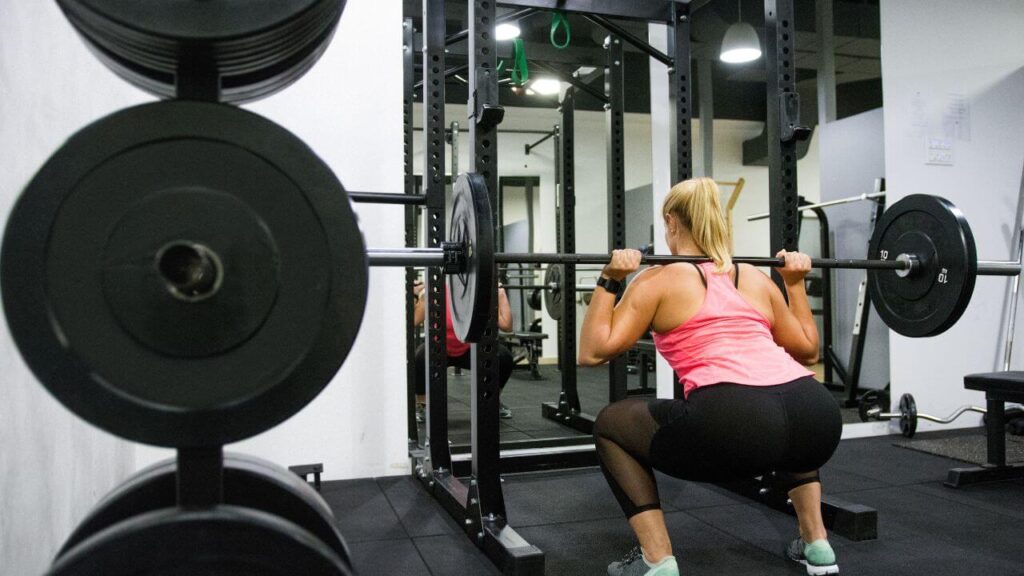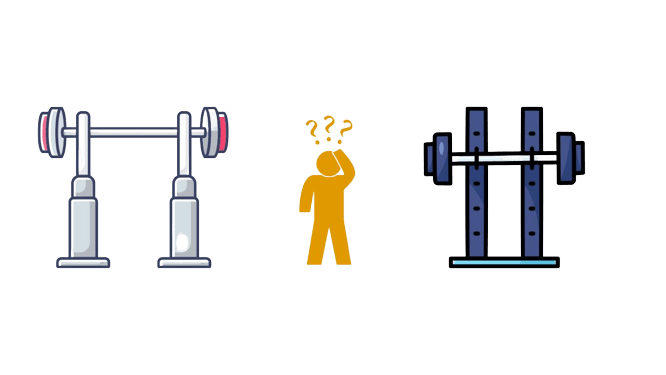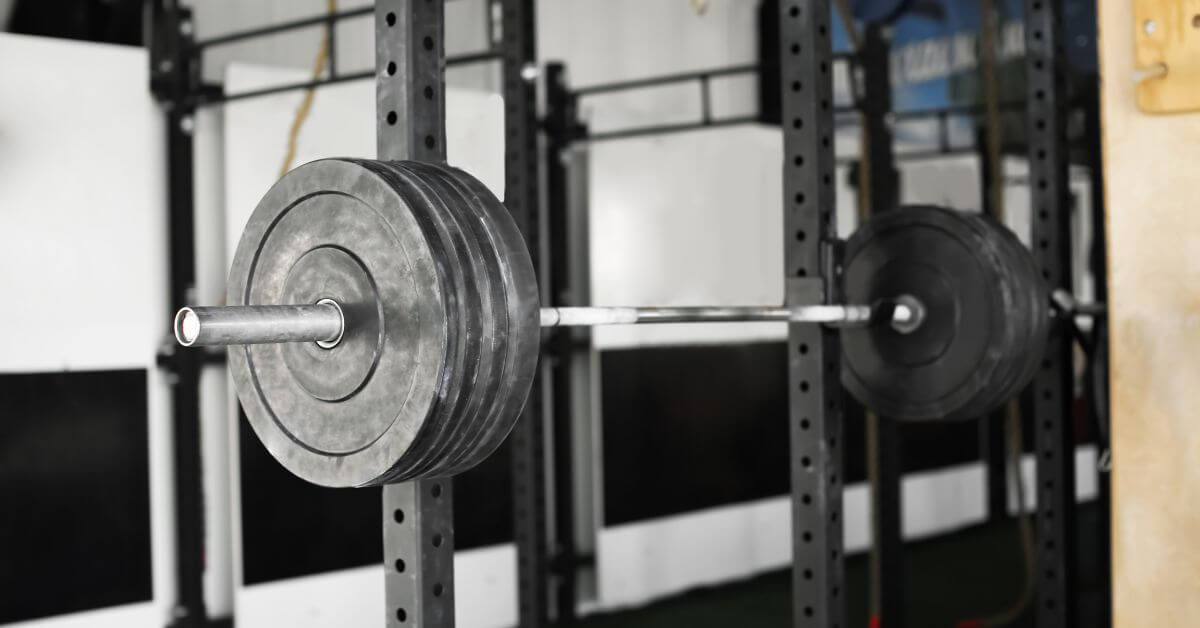Many recently decided to set up a home gym because of the expense of money and time.
Table of Contents
ToggleWhen equipping a home gym, the key is purchasing appropriate equipment and organizing the space because, let’s face it, the equipment is not small.
One of the essential pieces of equipment for your gym is the squat rack, which takes up space and requires a certain ceiling height. In this article, I will present everything you need to know when buying this particular device for your home gym.
How Tall Is a Squat Rack?
The squat rack is usually 80-84 inches tall, while the largest squat rack ranges from 92 to 96 inches. The shortest squat racks are between 68 and 72 inches. The first category is designed for taller people, while the second one is for smaller people.
Start Building Your Dream Body Today
Ready to elevate your fitness game without falling into the trap of dull, repetitive routines that just don’t deliver? Imagine sculpting your ideal physique and boosting your health, all while still enjoying life’s pleasures, like those irresistible weekend getaways and your aunt’s legendary cheesecake. With our online fitness and nutrition coaching service, you don’t have to compromise. Dive into a personalized fitness journey that blends perfectly with your lifestyle, not against it. Book your completely free discovery consultation today, and take the first step towards a transformation that doesn’t require giving up the joys of life.

“I was skeptical about online fitness coaching, but Functional Body Savage completely changed my perspective. Vanja and Radomir’s personalized approach and attention to detail have helped me achieve goals I never thought possible. I’m stronger, more confident, and grateful for their guidance.”
Emily Thompson, San Francisco, CA
Learn More About Our Online Coaching ServiceQuick Summary
- The squat rack is one of the key items needed to complete your home gym.
- There are two types of squat stands, fixed and adjustable.
- The average height of a fixed squat rack is 87 inches, while the average height of an adjustable rack is 64 inches.
- The tall power rack is an excellent choice if you have more space and a higher ceiling.
- There is a short power rack if you have a smaller space and a low ceiling.

What Is A Squat Rack?
A squat rack is a gym device that comes in the form of a large metal stand with different levels for supporting barbells loaded with weights. The purpose of a squat rack is to hold the loaded barbell and allow a weightlifter to lift the weight without injuries safely.
In addition, the full rack also allows you to easily load the standard barbell without sacrificing too much energy.
This comes in extremely handy when you exercise for strength and hypertrophy and need every bit of your energy devoted to the lifting. Many professionals and athletes prefer the full and half racks, along with free weights, for building a strong and well-versed lower body.
Check out our guide to the best budget squat racks to find one that won’t break your bank but still provides enough durability and quality workout sessions.
Squat Rack Dimensions
Squat and power racks come in different weights, sizes, categories, etc. All of that is based on the preferences and needs of the weightlifter.
General squat rack dimensions involve the squat rack’s width, height, and depth. There is no such thing as the universal standard rack dimensions since all human beings are different. However, on average, these are the measurements:
- Height: 90 inches
- Width: 40-50 inches
- Length: 24-50 inches
The two most important measurements are height and width, and they should serve as the primary factors when deciding to purchase a squat rack.
Height of an Average Squat Rack
The height of the average power rack averages 80 inches (203.2 cm), its width averages between 46 and 49 inches, and its depth varies from 47 to 53 inches.
The main difference between the higher and lower power racks is that the higher ones have 6 legs instead of 4, so you can achieve greater lifting depths if you have a giant machine.
It would be best if you chose power racks depending on your height, the room you are preparing to be your space for daily exercise, and the area you are ready to set aside for this device.
If you have lots of equipment, you may as well choose the option that will save as much space as possible and allow more room for exercising.
How Wide is a Squat Rack?
On average, squat racks are 50 inches wide. The most important thing regarding the width of the squat rack is to pick the one that will easily fit in your home gym when loaded with barbells and weight plates.
Many forget to add the barbell on the squat rack when purchasing, and that’s why they fail to have enough space in the home gym. Consider extra length from barbells and weights when placed on the squat rack.
You must always leave sufficient space on both sides for loaded barbells and weight plates. The width of 50 inches will provide adequate stability and prevent the barbells from tipping off.
The general rule includes two feet on each rack’s side for a comfortable working-out experience.
Full Sized Rack Dimensions
A full-sized rack is typically between 80 and 85 inches wide. However, you must add 24 inches on the sides to count in the barbell and extra space needed to have a comfortable working out experience.
Small Rack dimensions
On average, a small rack with no extensions is typically 40 inches wide. But when you add a standard 84-inch bar, you must count in the extra space of around 12 feet.
How to Use a Squat Rack?
To use the squat rack, you must adjust the rack, load the barbell, balance the barbell properly, lift and take a step back, and start squatting. Here is how to exactly do that.
Step 1: Adjust the Rack
First, you should adjust the rack according to your height. The racks that are too high or too low are risky and may evoke injuries with certain exercises. The rule of thumb, and my advice, is to adjust the height so the barbell sits at your middle chest area. However, feel free to tweak the height to maximize the benefits of your squat workouts.
Step 2: Load the Barbell
The second step is to load the barbell with the appropriate amount of weight. You should never load the barbell with a weight you cannot lift. Always start light and add additional weights as you are making progress. Also, always ensure the weights are equally distributed across both ends of the bar so you avoid getting injured.
Step 3: Balance the Barbell Properly
You must place equal weight on both sides of the barbell and ensure they are placed in the same order. Also, ensure the distance between the last weights loaded on the bar is equally distant from the middle of the bar. This will ensure maximal stability during the lifting phase.
Step 4: Lift & Take a Step Back
Get under the barbell, place it on your upper trapezius and deltoid muscles, and unrack it. Slowly take two steps back to free the space and allow the exercise without interruption.
Step 5: Start Squatting
Now it’s time to start squatting. We won’t go over the technique here but ensure your back is always flat, knees are in line with your toes, and heels remain on the ground.
How Much Space Do I Need for a Power Rack?
How much space you need for a power rack will depend on the free area and ceiling height of the room you are planning to predefine for your home gym.
On average, you need 12 – 20 inches of ceiling hanging from the height of your power rack to perform all exercises like overhead press, bench presses, and pull-ups on the pull-up bar without any problems.
Considering that the average height of a full power rack is 80 inches, you would need a ceiling between 98 and 104 inches high to place this device in the space intended for home gyms.
An average modern apartment or house has rooms of this height, but the problem arises if you have decided that your home gym will be in the garage because they often have lower ceilings than the rest of the home.
You also have to consider the surface area this device takes up.
You need between 12 and 18 inches of free space on all sides of the power rack to safely place and store weights and other functional gym equipment.
If we observe that the width of the power rack averages between 46 and 49 inches, you need from 60 to 70 inches to install this device safely.
When preparing the space for power rack installation, the key thing is to correctly and accurately measure the intended area to buy a device of the appropriate size.
Short vs Tall Squat Racks – Which Is Better for Your Home Gym?
Both bigger and smaller power rack has pros and cons.
Tall power racks provide a complete training experience, increased weight capacity, and enable you to complete your workout and perform exercises like bench pressing, overhead presses, shoulder presses, chin ups, Olympic lifts, and more.
They often come with 6 legs so you can reach greater depths during different exercises. You can put weights and other gym equipment on them and the like. They provide complete training comfort.
On the other hand, they are problematic because they take up a lot of floor space and require high ceilings, so they are not profitable if you want a small home gym.
They are also quite a bit more expensive than the smaller version of this device.
Short power racks serve to provide you with extra space for other exercises in your gym.
They are more compact, smaller, excellent for limited space, and much cheaper than tall racks, but they do not offer as much comfort and training possibilities as their taller versions. For example, the plate storage might be smaller, or sometimes even nonexistent.
Also, they can make training difficult for taller people.
Your choice of power rack should be influenced by the space intended for your home gym.
The short power rack is an excellent choice if you plan to make your space smaller with low ceilings.
If you are ready to set aside a larger room with higher ceilings in your home for daily training, then there is a tall power rack.
Types of Squat Stands
In general, there are two types of squat stands:
- Fixed Squat Stand – It consists of two upright posts with a fixed height. You move the hangers depending on the size you need.
- Adjustable Squat Stand – It consists of two upright posts with adjustable height. If you want to change the size, you need to raise or lower the post and leave it at the height you need.

Fixed Squat Stand Heights
The height of fixed squat stands varies from 72 to 111 inches, and the average height is 87 inches. Most machines of this type are between 80 and 92 inches tall.
Adjustable Squat Stand Heights
The height of adjustable squat stands varies from 55 to 70 inches, and the average height is 64 inches which is much less compared to the fixed one.
Since it is adjustable, it also has the lowest point you can lower it to, which is 42 inches on average.
How Tall Should My Squat Stand Be?
How tall should your squat stand be will depend on your height and the exercises you want to do.
Get a slightly larger squat rack if you want to do squats or overhead exercises. It would be best to measure the length of your arms and take a squat rack slightly higher than it.
FAQs
How Tall Ceiling Do You Need for Squat Rack?
You need a 100 to 110 inches tall ceiling for a squat rack. It is always better to have some room left between the squat rack and the ceiling, so you can be sure there were any problems.
How Tall Is Rogue Squat Rack?
Rogue squat racks are 84 inches tall on average. There are several different Rogue squat racks in different sizes. The tallest squat rack of this brand is 111 inches tall, while the height of the lowest model is 70 inches.
What Should You Do if You’re Still Short on Space?
If you are still short on space, you should pick the short squat rack. It will take up less space, and you won’t have problems with height and placement, but you won’t enjoy as much comfort as higher squat racks provide.
Which Squat Rack Should You Buy?
There are several different squat racks that you can purchase for your home gym.
Depending on the space you are ready to devote to this essential part of your home gym, the height of the ceiling and the money you are prepared to spend on the purchase vary.
Lucky for you, this machine comes in various sizes and types, giving you plenty of options for your home gym.
Please say in the comments below which squat rack you decided and why it was your choice.
Start Building Your Dream Body Today
Ready to elevate your fitness game without falling into the trap of dull, repetitive routines that just don’t deliver? Imagine sculpting your ideal physique and boosting your health, all while still enjoying life’s pleasures, like those irresistible weekend getaways and your aunt’s legendary cheesecake. With our online fitness and nutrition coaching service, you don’t have to compromise. Dive into a personalized fitness journey that blends perfectly with your lifestyle, not against it. Book your completely free discovery consultation today, and take the first step towards a transformation that doesn’t require giving up the joys of life.

“I was skeptical about online fitness coaching, but Functional Body Savage completely changed my perspective. Vanja and Radomir’s personalized approach and attention to detail have helped me achieve goals I never thought possible. I’m stronger, more confident, and grateful for their guidance.”
Emily Thompson, San Francisco, CA
Learn More About Our Online Coaching Service





